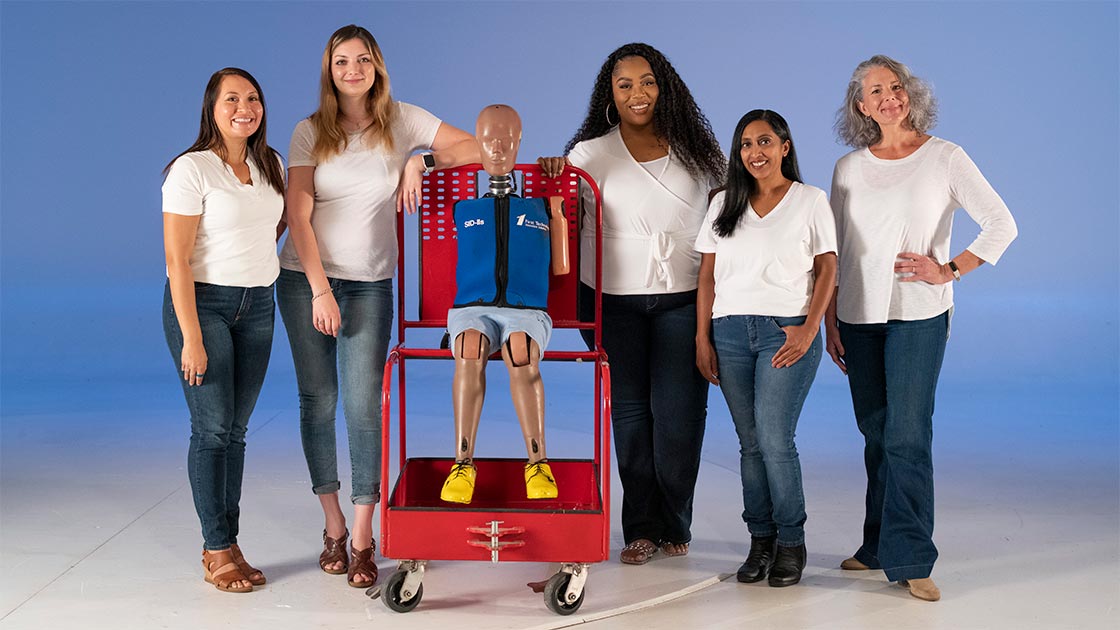Insight
Improving safety for women requires more than a female crash test dummy
September 15, 2022

Is crash testing biased against women?
It’s a fair question. After all, the safety improvements spurred by vehicle testing have not erased disparities in risk. Although more men than women are killed in crashes, women who are involved in crashes are more likely to be seriously injured than men.
And, as some safety advocates have pointed out, the frontal crash tests conducted by IIHS and the government use a crash test dummy that represents an average-size man. They are urging the use of a more modern, female dummy in tests.
While it’s tempting to believe that putting a female dummy in the driver seat for crash tests will automatically result in safety improvements that benefit women, the reality is more complex. Improving safety for women requires a more nuanced understanding of the problem — and of the purpose and limits of crash test dummies (more on that in a minute). We also need to consider other tools besides physical dummies that can help address a range of injuries in different types of crashes for all shapes and sizes of people.
A closer look at injury rates
Last year, my colleague Matthew Brumbelow and I set out to better understand what’s behind the higher female injury rate by analyzing injuries of men and women in police-reported tow-away crashes. We found that in frontal crashes women were 3 times as likely to experience a moderate injury such as a broken bone or concussion and twice as likely to suffer a serious one like a collapsed lung or traumatic brain injury.
But we wanted to know why women were being injured more frequently and whether it was something that we could measure in crash tests. How much of the discrepancy could be attributed to differences in the types of crashes men and women are involved in and the vehicles they drive? After all, injury risk differs based on the size of the vehicle and the circumstances of the crash, and these variables often favor men. Men tend to drive bigger, heavier vehicles than women, and they are more likely to be behind the wheel in the striking, rather than the struck, vehicle in a side or front-to-rear crash.
To compare apples to apples, we repeated the analysis with a narrower set of crashes. This time we looked only at single-vehicle crashes and two-vehicle crashes in which the vehicles were a similar size and weight.
In these crashes, women and men had similar odds of head and chest injuries — the types most likely to be fatal — but women remained twice as likely to suffer moderate injuries. The higher injury rates for women were primarily in the lower leg and foot.
This study tells us that a big part of the problem comes down to differences in crash types and the interaction of different vehicle types and sizes. Those issues can be addressed, but not through crash testing. Instead, we should implement solutions available today to make striking vehicles less deadly to other road users. One such solution is automatic emergency braking, which has spread rapidly through the vehicle fleet thanks to a voluntary manufacturer commitment but is still absent from many of the heaviest passenger vehicles, including many popular pickups. Another available technology is intelligent speed assistance (ISA), which can either prevent speeding or issue warnings if speed limits are exceeded. Less speeding translates into fewer vehicles becoming lethal projectiles. ISA is now required on new vehicles in Europe, but U.S. regulators have not acted.
The limits of dummies
What about the high rate of leg and foot injuries among women? Could using a female dummy in frontal crash tests help with that? To answer, we first need to zoom out and get a clearer picture of what a dummy is and isn’t.
A crash test dummy helps us predict whether a person will get injured in a crash. Although it’s a sophisticated tool, it’s a crude representation of the complexity of the human body. When we run a test, a single dummy — made of metal, vinyl and rubber and equipped with sensors — has to stand in for a diverse population of humans who vary widely in their weight, height, age, posture and other characteristics.
The first crash test dummies didn’t attempt to capture any diversity: They were based on men’s bodies and evolved from research conducted by the U.S. Air Force aimed at testing the safety of aircraft, ejection systems and parachutes. At the time, few women were flying or jumping out of planes. The Hybrid III frontal crash test dummies we use today are direct descendants of these early ones. They come in different sizes representing an average-size man, a large man and a very small (5th percentile) woman, as well as a 10-year-old, 6-year-old and 3-year-old child. The small female version has body dimensions and a pelvic design specific to women, but otherwise is largely based on the original, midsize male Hybrid III.
We use the midsize male Hybrid III in the driver seat for all our frontal ratings tests and in the front passenger seat for the passenger-side small overlap front test. This dummy represented the average male decades ago but, compared with today’s population, it’s lighter than the average man and weighs about the same as the average woman. (Its height is still average for a man.) Since there is no dummy representing an average-size woman, this male dummy is our best tool to ensure the seat belts and airbags can restrain a typical person of either sex.
An updated version of our moderate overlap test that we are rolling out later this year uses a small female Hybrid III dummy in the rear seat, where its size could also represent a pre-teen child. In addition, we have been using a related, small female dummy designed for side crashes in the front and rear seat in our side crash tests since we started them in 2003. Those tests prioritize shorter occupants because they are more vulnerable to head injury in side crashes, especially with some early airbag designs.
Even as a stand-in for men, the Hybrid III dummy provides at best an approximation of how the body is affected by a crash. It is based on old, limited data from experiments conducted on human subjects and on testing using cadavers and animals. However, the data that we and others in the crash-testing community have accumulated over decades of using it adds substantially to its value. The dummy’s sensors record accelerations, forces and deflections (e.g., how far a rib is pushed inward), and by comparing these measurements from many tests to injuries in many real-world crashes, we have gotten very good at interpreting these numbers.
When it comes to the lower leg and foot injuries that women disproportionately experience, the 50th percentile Hybrid III gives us some information, and it’s unlikely that a smaller, female version would tell us anything different. Newer, more sophisticated dummies with additional sensors have been developed and may someday provide deeper insight into the problem. But much more work is needed to first understand how those injuries are occurring and how to interpret data from the newer dummies. Moreover, even a more sophisticated dummy is still just one dummy, standing in for a diverse population.
Other tools
Fortunately, dummies aren’t the only tools at our disposal. Right now, we’re ramping up our capacity to conduct virtual crash testing with computational modeling. As a complement to physical tests, virtual tests can be conducted with an unlimited number of models representing the diversity of the human population. We’re also continuing to study real-world crashes to bring different types of injuries and segments of the population into sharper focus. Finally, we are urging our colleagues in labs that conduct cadaver testing to expand and diversify that work in order to strengthen and improve the data behind both our physical and virtual testing tools.
As we consider changes in our testing programs, we should keep in mind that we are already moving in the right direction. A study released last month by the National Highway Traffic Safety Administration found that crash injury disparities between men and women are much smaller in newer vehicles than in older ones. The crashworthiness improvements of recent years have resulted in particularly big benefits to women. We need to speed up this progress while being careful not to derail it.
A female dummy in the driver seat would carry a certain positive symbolism for women, but I want more for us than symbolism. To truly achieve equity in crash safety, we need to recommit ourselves to known solutions that we can implement today and to continued research that will point the way forward in the future.
